Page 1
Moderately continental climate characterized by low clouds, scanty atmospheric precipitation, rapid heating of the air during the day and in summer and rapid cooling at night and in winter, large temperature drops, little snow, deep freezing of the ground.
The region is characterized by a temperate continental climate with long winters and short, cool summers. The average annual air temperature is 0 C. Absolute minimum The temperature is -41 6 C, and the maximum is 29 5 C. During the year, 375 mm of precipitation falls in the forefront, the largest amount (50 - 60 mm per month) falls on the summer months, the smallest (14 mm) - in February.
This article has been split 35 times. We have spent many hours collecting this information. If you liked it, please share it. Spain is a country with a wide variety of climates. Anyone can see that in a few hours you can set off from the green and hazy landscapes of the Basque Country to the arid Teruel or Cape La Nao.
In addition to this, the location of the peninsula between the tropical and temperate zones makes it an area where the influence of the polar jet stream mixes with their associated fronts and storms and the high tropical pressure of the Azores anticyclone. This adds a lot of variability in temperatures and precipitation.
The territory under consideration is characterized by a moderate continental climate with an average water precipitation of 580 mm with an evaporation of 400 m; 78% atmospheric precipitation falls in the warm season. The plant is located in the floodplain and on the first terrace above the floodplain. The rocks of the Upper and Middle Carboniferous are heavily karst in some places. The considered aquifer is hydraulically connected with the Upper Carboniferous horizon, and in areas where the Middle Carboniferous rocks are directly overlain by alluvium, and with the horizon groundwater... The waters are pressurized, the supply area coincides with the area of distribution. The natural protection of the horizon is weak.
In summer, characteristic anticyclones tropical zones, like one of the Azores, move northward until they find themselves on the border of the Cantabrique conillera and the Pyrenees. This is why this time of year is characterized by prolonged summer drought and frequent waves heat caused by the arrival of air masses from North Africa. The fronts and storms characteristic of the temperate zone only affect the Cantabrian strip, where it often rains, albeit in lesser numbers than at other times. The rest of the peninsula often experiences storms, which form when surface air, which is very hot as a result of the day's insolation, rises and cools.
The Ivanovo region has features of a temperate continental climate with fairly well-pronounced seasonal differences in the weather regime. Precipitation is preceded by a thunderstorm. The frost-free period lasts 120 - 135 days. In mid-November, a stable snow cover is established, which lasts until mid-April and has a duration of 150 - 170 days. The highest number of snowstorm days is observed in January and February.
In winter, the characteristic fronts and storms of the temperate zone move southward and affect the entire peninsula. A characteristic feature of this time of year is that the passage of storms, accompanied by rain and snow, alternates with other dry and cold periods, when cold air enters the peninsula from the polar regions of Northern Europe and Siberia.
Spring and autumn are two seasons of transition, in which there are fuzzy situations that are characteristic of winter or summer. Late frost is often found in April or May, and summer days in October or November. Climatic conditions in Spain, given their heterogeneity, are difficult to classify, but there is wide agreement on the differentiation of the following major groups.
Natural drying conditions are given for a temperate continental climate.
The central part of the Great Plains, characterized by a temperate continental climate, belongs to an area with a dry growing season, which lasts 200-240 days. Average annual precipitation is 350 - 450 mm, but they fluctuate from year to year. According to the conditions of heat supply and humidification Eastern The area is suitable for growing crops such as grain corn, winter wheat, sugar beets, forage grasses.
This occurs on the northern edge, from Galicia to the western Pyrenees, which remains for a whole year under the influence of moderate circulation. Mediterranean climate in the strict sense of the word. It is located in the coastal strip Mediterranean Sea... This climate is characterized by dry and dry summer and a few rains and mild winters. Precipitation occurs mainly in spring and autumn, in cold fall situations that cause heavy rainfall. Dry seasons alternate with rainy seasons. Mediterranean climatic interior or continental. It stretches from the center and east of the plateau, the Ebro Valley and inside Andalusia. With a very cold winter and warm summer because he does not attain marine influence. In summer storms form the Mediterranean climate, oceanic or continental, softened. In the eastern part of the peninsula. Summers are dry, as in the previous case, but the rains are more abundant and occur mainly in winter, with the arrival of fronts from the Atlantic. Winter temperatures are mild.
- Oceanic climate, also called humid temperate.
- The rain is high, distributed throughout the year.
- Differences in temperature throughout the year are small, with cool summers and mild winters.
- The landscape and vegetation are very similar to those of Western Europe.
Ochreous soils are formed in a cold humid temperate continental climate under herbaceous stone and white birch forests in areas of predominantly moderate ash falls with a balanced ratio of the processes of soil formation and lithogenesis.
Equipment and products that are successfully operated in a temperate continental climate quickly fail when operating in tropical conditions.
In Spain, there are four main climatic zones on the peninsula: Mediterranean climate, oceanic climate, continental climate and mountainous climate. Mediterranean climate. This is the dominant climate in most of the territory. Summers are warm and dry and winters are mild. Precipitation is irregular and concentrated in autumn, especially in coastal areas. Precipitation decreases towards the south, making the summers hotter and the winters milder. It is considered to be the arid Mediterranean climate.
The dominant biome is the Mediterranean forest. Climate Ocean. Characteristics of the North and Northwest of the peninsula. Summers are cool, mild winters and frequent rainfall at any time of the year. In the coastal zone, the marine influence makes the climate more temperate. Storms and winds in the west cause rainfall, more abundant in the west. The dominant biome is deciduous forest.
Soils of the steppe and forest-steppe zones, formed in a temperate continental climate, with a non-flush water regime. Bordered by gray forest soils in the north and chestnut soils in the south.
The coatings with NTs-132 enamels (in two layers on the primed surface) are weather-resistant and keep their protective properties in a moderate continental climate for at least 15 years.
Continental Mediterranean climate. From the regions of the interior, Extremadura, the Plateau and the Ebro depression. There is a large temperature difference between winter and summer. Precipitation is not very abundant, at best it reaches 400 mm per year. We find forests of oaks, pines and bushes. Mountain weather. It is located in the Cantabrian ridge, Pyrenees, Cordillera Beta and Teide. Precipitation is often found in the form of snow.
Coniferous, pine and spruce forests are mainly developed in these areas. Climate on Canary Islands... With very even and uniform temperatures throughout the year between precipitation and precipitation, similar to that of the Mediterranean climate, although generally low. The most characteristic of this climate is the great influence of the mountains. Masses of air coming from the sea are loaded with water vapor, which condenses when it hits the mountain slopes, forming seas of clouds that humidify the places in which they are located, even if it is not rain.
Coatings with PF-115 enamels (in two layers on the primed surface) are weather-resistant and, in a moderate continental climate, retain their protective properties for at least 2 years for red and cherry colors and at least 3 years for other colors.
The coatings with NTs-132 enamels (in two layers on the primed surface) are weather-resistant and retain their protective properties in a temperate continental climate for at least 15 years.
Distribution climatic conditions in Spain. The following diagram shows the different climatic zones that we find in Spain. All territories that form Spain are located in temperate zone our planet. The continental climate is characterized by important temperature differences between stations and between day and night. The frost is frequent and there is little rainfall. This climate appears, as a rule, in the middle latitudes, between the tropics and the poles. It is common in regions far from the moderate climate effects of oceans, inland continents, or in areas isolated by mountain ranges.
Coating with BT-177 paint (in two layers on the primed surface) must retain its protective properties in a temperate continental climate for at least two years.
The territory of Russia is huge, and therefore the climatic conditions in its various regions are quite different. Each belt has some common features: temperature and precipitation regime depending on the season. But at the same time, depending on various factors (for example, from the proximity of the ocean), they can vary slightly and within one climatic zone... These differences are especially characteristic for the temperate climatic zone, which is divided into four climatic zones. This is the result of the great extent of the territory of Russia from west to east.
It is more common in the northern hemisphere than in the south, and is present in Siberia, the interior of the United States and Canada, Central and of Eastern Europe and in the interior of China. Its almost complete absence in the southern hemisphere is due to the fact that most of the land located in mid-latitudes is located in the northern hemisphere, since those located in the northern hemisphere are narrow and have oceans close to them, as in South Africa... However, continental climates can be found in regions southern hemisphere such as Central Argentina and Chile.
Arctic climate
In this climatic region there are zones arctic deserts and tundra. Here earth surface warms up rather weakly, which is the reason for such harsh conditions and, as a result, plant and animal world this area is rather sparse. In addition to the fact that cold air prevails here throughout the year, the severity of climatic conditions is also intensified by the long polar nights. The air temperature in winter can drop to -60 ° C. Winter in this climatic zone is extremely long (it lasts about 10 months). The number of seasons here is reduced to two: spring and autumn are absent. Summers are also quite cold (temperatures usually do not rise above 5 ° C).
On the other hand, the continental climate can be viewed as a deformation of other climates due to the absence of a benign effect of the World Ocean or isolation from orographic accidents. Based on this, the climate of some regions of the planet located in the intertropical zone, like Iran, and even some parts of the Sahara Desert, can be characterized as continental.
There are several subtypes of the continental climate. This is the one given in Siberia and Canada. The continental monsoon climate typical of North China and North Korea is milder than the previous one. The climate of the temperate continent is typical for the European part of Russia and Central and Eastern Europe, as well as in the central and northern parts of the United States and in the southeast of Canada. Although it is similar to a monsoon, temperatures are lower and precipitation is also more irregular. This can be seen as a degeneration of the oceanic climate.
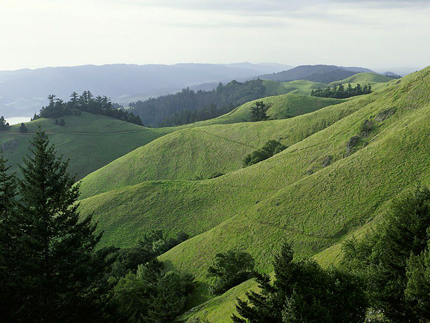
Arkhangelsk region, summer
On the islands of the Arctic Ocean, temperatures are slightly higher in winter. This is due to the fact that the water masses that have accumulated heat give it to the air. In the western part of the Arctic belt, where the influence of the warm North Atlantic Current affects, average annual temperatures also slightly higher. On the islands, rainfall in the Arctic is quite limited. They usually fall out in the form of snow.
The continental Mediterranean climate appears in the center of the Iberian Peninsula, inside Greece, in the north of Italy and around Santiago Chile, among other regions. Winter temperatures are warmer than typical Mediterranean climates and rainfall does not exceed 400 mm per year. Finally, an arid continental climate occurs in Central Asia, Mongolia, and parts of the Midwest of the United States. A temperate climate prevails in most European countries, North America, Argentina, parts of Australia, China and Japan.
Subarctic climate
Winters in this climatic zone are quite long and cold, although still less severe than in the Arctic. Summers are slightly warmer (up to 12ºC), but also quite short. The amount of precipitation is approximately the same as in the Arctic zone (200-400 mm per year). They fall out more often than in the Arctic, but in quantitative terms they are inferior to them. The subarctic climate is also characterized by cloudiness and strong winds... This is due to the passage of Arctic cyclones.
It is subdivided into a temperate oceanic climate, a temperate Mediterranean climate, and a continental temperate climate. Affected areas temperate climate... This climate is one of the main recorded in Brazil. Equatorial tropical tropical latitude Tropical Atlantic tropical semi-arid subtropical.
Basic characteristics of a tropical climate
Moderate oceanic or oceanic weather
- Mild winters and summers with high temperatures.
- High rainfall is well defined.
Temperate climate
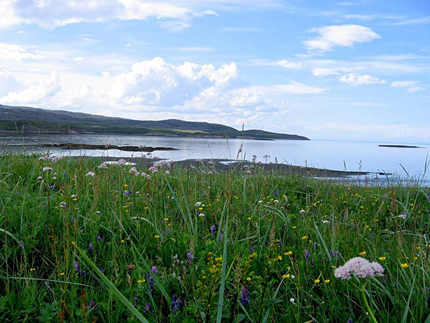
Kola Peninsula
This is the largest climatic zone in Russia in terms of area. That is why it is customary to divide it into four zones: moderate continental, continental, sharply continental, monsoon climate... A characteristic feature of the entire temperate climatic zone is the presence of clearly defined four seasons: spring, summer, autumn and winter. Moreover temperature conditions summers and winters differ quite sharply from each other.
This is the climate that prevails in the eastern and northeastern states of the United States, northeastern Argentina, eastern Southeast Australia, New Zealand, China, Japan, and southeastern Chile. It is also present in northeastern Europe and the British Isles.
- Average monthly moderate temperatures due to proximity to the sea.
- Winter with temperatures above 5º There are no negative winter temperatures.
- Dry months.
- Rainfall all year round.
Moderate continental climate
The main features of this type of temperate climate are hot summers (in its middle, the temperature rises to 30 ° C) and frosty winters (temperatures drop to -30 ° C). Rainfall varies depending on the proximity to the Atlantic. The formation of the climate occurs under the influence of the transfer of Atlantic air masses. Humidification in the moderate continental climate zone varies from excessive in the north, northwest, to insufficient in the south, southeast. This is the reason for the change in natural zones (from taiga to steppe). The air masses of the Atlantic, moving inland, acquire more and more continental properties.
Trees of the tree species are typical of this biome. In the fall, these trees show red, orange, gold and copper leaves, coloring the landscape. In regions with a temperate Mediterranean climate, summers are dry and winters are mild and quite rainy.
It can be said that this climate represents only two seasons - summer and winter, because spring and autumn go unnoticed due to their short duration. This type of climate is typical for the center of the United States, inner Europe, and northern Asia.
- Long, dry and intense cold winters.
- Temperatures of the 15th negative in winter.
- New frequent falls in winter.
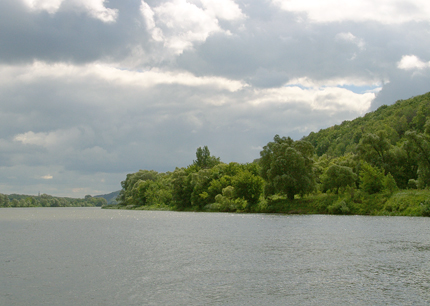
Voronezh region, Don river
Continental climate
Formed under the influence of air masses temperate latitudes coming from the west. At the same time, colder Arctic regions are moving from north to south. air masses and to the north continental tropical air. As a result, the north receives 3 times more precipitation than the south. Here the difference between summer and winter temperatures increases even more. The average temperature in July reaches 26 ° C, and in January -25 ° C. The natural zones of the continental climate also change in the direction from north to south from taiga to steppe.
Sharply continental climate
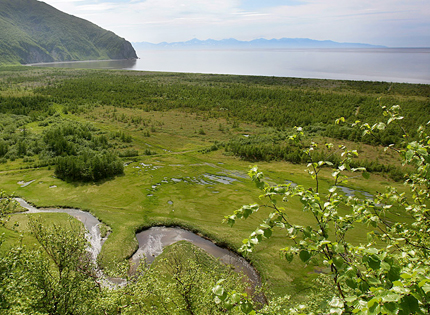
Magadan region, environs of the village. Atargan
This climatic zone is dominated by continental air of temperate latitudes. Characteristic feature The sharply continental climate is characterized by low cloud cover and a small amount of atmospheric precipitation, which fall mainly in the warm season. In addition, due to low cloud cover, the earth's surface warms up rather quickly in summer and cools down in winter. The result is hot summers and freezing winters. Low precipitation in winter contributes to strong soil freezing and preservation permafrost... Within this climatic zone there is only one natural area- taiga. This is due to the fact that within the sharply continental climate there are practically no temperature differences between north and south.
Monsoon climate
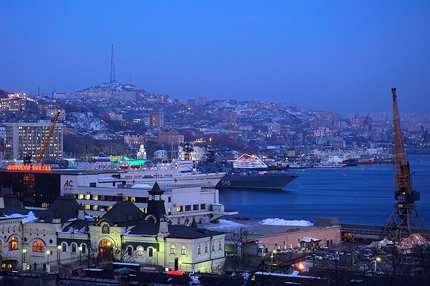
Vladivostok
As the continent cools in winter, the Atmosphere pressure, and cold and dry air masses move towards the ocean, where the air is warmer (water cools more slowly). In summer, the mainland warms up better than the ocean, and cold air from the ocean rushes to the continent. This creates strong winds called monsoons, hence the name of the climate. Sometimes typhoons even form here. In this regard, precipitation also falls mostly in summer and in a fairly large amount. If they start at the time of melting snow, then floods usually occur in these places. Humidification throughout this climatic zone is excessive. Since in summer enough cold air enters this territory from the north, it is quite cool here ( average temperature in July 15-20 ° C). In winter, the temperature sometimes drops to 40 ° C (average about 25 ° C).
Other climatic zones(subtropical, tropical, equatorial) on the territory of Russia are absent.




